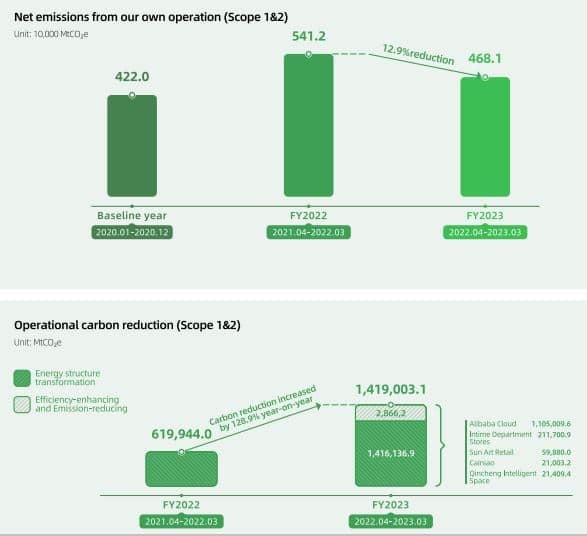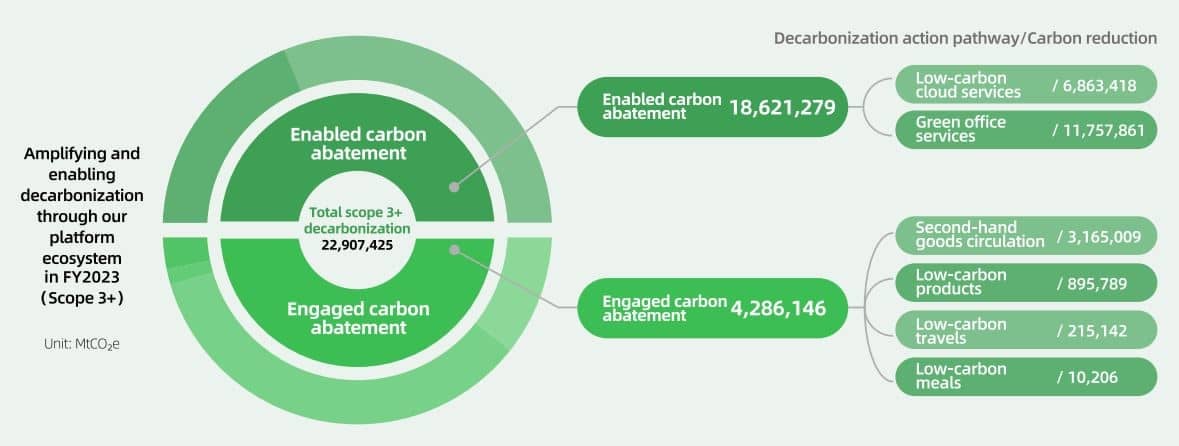In a bold stride towards a greener future, Chinese e-commerce titan Alibaba has successfully slashed its net carbon emissions from direct operations by an impressive 13% in the past financial year. This significant reduction is a part of Alibaba’s ambitious goal to achieve carbon neutrality by 2030.
The retail behemoth unveiled this remarkable achievement in its 2023 Environmental, Social, and Governance (ESG) report. The report also highlighted Alibaba’s groundbreaking progress towards its ambitious Scope 3+ goal, which aims to eliminate a whopping 1.5 gigatons of carbon emissions across its digital ecosystem by 2035. This marks the first time the company has reported on this pioneering sustainability effort.
Highlighting this milestone, Alibaba’s outgoing CEO and Chairman, Daniel Zhang Yong noted in the report:
“Despite challenges in the macro environment, geopolitical uncertainties in the post-pandemic era, and new trade-offs between sustainable development and economic growth, we achieved notable progress in our ESG initiatives.”
And one of these achievements is the CO2 emission reduction of almost 23 million metric tons throughout the value chain. This includes Scope 3 emissions.
Alibaba’s Carbon Emissions and Reductions
In 2021, the Hangzhou-based company made three climate pledges as follows:
- Decarbonize operations (Scopes 1 and 2): achieve carbon neutrality in own operations by 2030.
- Green the value chain (Scope 3): cut emission intensity by 50% from 2020 levels in collaboration with value chain partners. Alibaba Cloud will reach Scope 3 carbon neutrality by the same year.
- Enable a low-carbon circular digital ecosystem (Scope 3+): to achieve 1.5 gigatons of carbon reduction over 15 years across the digital ecosystem. Alibaba will leverage its digital platforms to attract more participation from stakeholders in reducing emissions.
In its 2023 financial year, Alibaba took huge steps toward meeting these targets.
As shown in the charts, the e-commerce giant emitted around 4.7 million metric tons (Mt) of CO2 equivalent, down 13% from the previous year. By cutting 1.4 million Mt of CO2e with clean energy and smart energy management, carbon reduction increased 129%.
Alibaba Net Carbon Emissions and Reductions

For instance, logistics subsidiary Cainiao has reduced packaging materials by 184,000 tons in 2023 by recycling used packages. Cainiao urged consumers to reuse cardboard boxes at pick-up points resulting in 23 million boxes recycled at Cainiao Posts.
Alibaba teamed up with Nike to do door-to-door recycling across thirty Cainiao campus stations nationwide in China.
Combining these efforts with the company’s projects on carbon removal and carbon credits, its Scope 3 carbon intensity dropped by almost 6%. Alibaba focuses on supporting nature-based climate solutions.
The So-called Scope 3+
What makes 2023 a groundbreaking year for the Chinese company is the introduction of its initiative called Scope 3+ results. This new effort goes beyond Scopes 1, 2, and 3, which reduced a total of around 23 million MtCO2e.

Carbon88 allows users to show the actions they’re taking to reduce their carbon footprint. These include everything from bringing their own cups to using reusable bags.
Similarly, Amap, Alibaba’s navigation platform, has seen over 30 million people opting for low-carbon travel options like walking. This led to a reduction of 215,000 MtCO2e. Moreover, the company’s food delivery platform, Ele.me, helped save resources by allowing users to opt out of cutlery on over 1.4 billion orders.
Scope 3+ basically refers to a low-carbon circular digital ecosystem with broader cooperation from stakeholders.
A Green Cloud
Alibaba’s cloud computing subsidiary also significantly contributes to its climate goals. The report said that the proportion of clean electricity used in its self-built data centers in China increased from 21% in 2022 to an impressive 54% in 2023.
This remarkable achievement is due to the improved implementation of energy-saving technologies such as liquid-cooling server technology and power management optimization. As a result, total power usage was down to 1.215 in the period from 1.247 a year earlier.
Alibaba Cloud’s efforts to replace traditional IT with cleaner and greener cloud computing have boosted corporate users’ efficiency. It also reduced its emissions, avoiding a significant 85% of CO2 emissions, as Carbon Trust reported.
Moreover, the cloud’s AI-driven sustainability platform has assisted thousands of enterprises worldwide in monitoring, analyzing, and optimizing their CO2 emissions.
Overall, Alibaba Cloud realized over 1 million MtCO2e of emission reduction in the company’s own operations (Scopes 1 & 2) and 0.4 million MtCO2e throughout its value chain (Scope 3).
These results stated in its ESG report emphasize Alibaba’s commitment to environmental responsibility. It sets a shining example for other companies to follow in their quest for a greener future.

